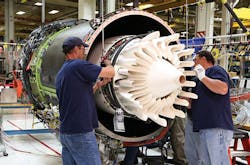GE Aviation is promising to develop a ‘blueprint’ for industrialized production of ceramic matrix composite (CMC) components, the advanced-material parts it is relying on to reduce weight and improve performance characteristics for its jet engine and land-based gas turbine systems.
In a jet engine, such as the LEAP series or the forthcoming GE9X, CMCs in the engine can save millions of dollars annual in operating and maintenance costs. Thanks to an engines’ lighter CMC-based structure, a 1% reduction in fuel consumption can save over $1 million/year for commercial air carriers.
GE Aviation projects that its next generation CMC material technology will improve fuel efficiency by 1-2%.
CMCs are formed with silicon-carbide (SiC) ceramic fibers in a SiC matrix, and then coated with proprietary ceramic material. GE’s Global Research Centers and industrial businesses have been developing commercial applications for CMCs for over two decades. Last year, the group started construction of two adjacent plants in Huntsville, Ala.
When that $200-million project is completed, one plant will produce SiC ceramic fiber (the first operation in the U.S. to do this), while the second will use these SiC ceramic fibers to produce unidirectional CMC tape required to fabricate CMC components.
The Huntsville complex will produce up to 20 metric tons/year of CMC parts, and employ about 300 when fully operational.
GE Aviation noted that the amount of CMC raw material it uses to produce turbine and engine parts this year will be approximately 20 times greater than it was in 2007. For example, one CFM International LEAP commercial aircraft engine uses approximately 1 kg of CMC material. That engine program is expanding on the strength of demand for the Boeing 737 MAX aircraft, and other new commercial jets. CMCs also will be a significant element of the design of the forthcoming GE9X engine, which will power Boeing’s new 777MAX beginning in 2019.
“We continue to make great progress,” according to Huntsville site leader Jon Lyford. “The engineering and construction teams are on track to start placing process equipment by October. The CMC prepreg facility commissioning will be complete in the summer of 2018. The CMC fiber facility commissioning remains targeted for the spring of 2019.”
The Huntsville plants are just the latest development in this expansion: over the past 10 years, GE Aviation noted it has invested over $1.5 billion to develop, expand, and commercialize its CMC technology to market. It established a CMC laboratory in Evendale, O., to develop CMC production designs; set up a low-rate production center in Newark, Del., for CMC raw material and components; and opened a full-rate production plant in Asheville, N.C., to mass produce CMCs, including the static turbine shrouds flying in CFM LEAP engines
By 2020, GE Aviation predicts it will have over 750 U.S. employees dedicated to CMC component manufacturing.
About the Author
Robert Brooks
Content Director
Robert Brooks has been a business-to-business reporter, writer, editor, and columnist for more than 20 years, specializing in the primary metal and basic manufacturing industries.
